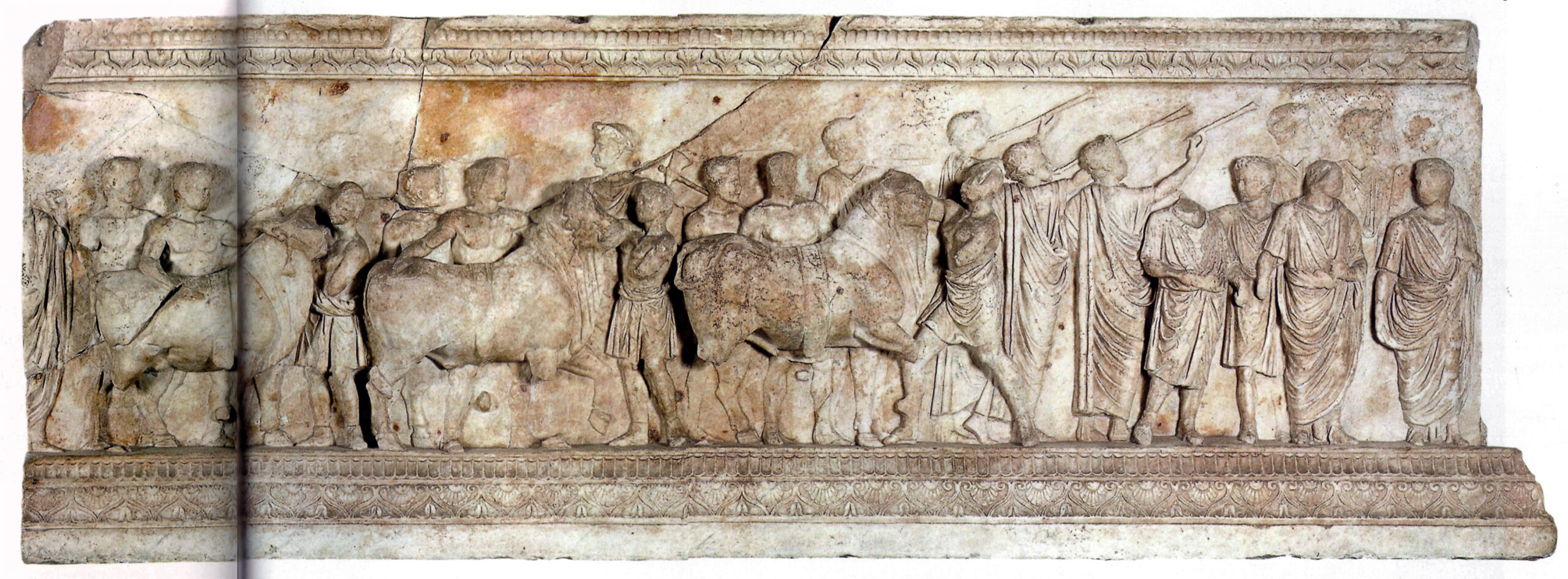Funeral procession of Alexander the Great
| TITLE: |
| Funeral procession of Alexander the Great |
| DATE: |
| 321 BC |
| TEXT: |
| BEKKER, I.; DINDORF, L; VOGEL, F.; FISCHER, K. T. (1905): Diodorus Siculus, Bibliotheca Historica, Books XVIII-XX. 18.26-28 MEUSEL, H.(1871): Pseudo-Callisthenes. Nach der Leidener Handschrift Herausgegeben, Hist.Alex. 3.34 |
| EDITIONS/TRANSLATIONS: |
| BEKKER, I.; DINDORF, L; VOGEL, F.; FISCHER, K. T. (1905): Diodorus Siculus, Bibliotheca Historica, Books XVIII-XX. 18.26-28 GARCÍA GUAL, C. (1977): Pseudo-Calístenes. Vida y Hazañas de Alejandro de Macedonia, Biblioteca Clásica Gredos, Madrid HAIGHT, E. H. (1955): The Life of Alexander of Macedon by Pseudo-Callisthenes, New York |
| KEYWORDS: |
| Word used to mean procession: |
| πορεία (a journey, Ps.-Callisth.) κατακομισθῆναι (escort / to bring into a place of refuge, Diod. |
| Word used to mean the cult images: |
| Sarcophagus / coffin (λάρναξ, Ps.-Callisth) Covered carriage (ἁρμάμαξα, Diod., esp. used by Persians, e.g. [“Ξέρξης] μεταβαίνεσκε ἐκ τοῦ ἅρματος ἐς ἁρμάμαξαν” Hdt.7.4) |
| Gods or other entities named: |
| Ps.-Callisth.: Alexander the Great, Mithra, Ptolemy I, Zeus, High Priest of the temple of Memphis Diod.: Arrideus, Victory (Νίκη); Ptolemy I |
| Description of the cult images: |
| Alexander’s lead coffin (ἐν μολιβδίνῃ λάρνακι, Ps.-Callisth.) was carried in a wagon (ἁμάξης, Ps.-Callisth.) / covered carriage (ἁρμάμαξα, l. 26.1; καμάρα —with an arched cover—, 26.5, Diod.), which is the main subject of Diodorus’ passage: ἄξιον ὑπάρχον τῆς Ἀλεξάνδρου δόξης (…) κατὰ τὴν δαπάνην (…) καὶ τῇ κατὰ τὴν τέχνην περιττότητι περιβόητον ὑπῆρξε Golden sarcophagus (χρυσοῦν σφυρήλατον) with aromatic herbs (ἀρωμάτων); armour (ὅπλα); precious stones (λιθοκόλλητος); reliefs; garlands; bells (κώδωνας) Four golden Victories carrying trophies in the four corners of the covered carriage (κατὰ δὲ τὰς τῆς καμάρας γωνίας ἐφ᾽ ἑκάστης ἦν πλευρᾶς Νίκη χρυσῆ τροπαιοφόρος) lift over four Ionic columns (Ἰωνικὰ κιονόκρανα) surrounded by golden acanthus Four panel paintings (πίνακας): (1) war chariot (ἅρμα) lead by Alexander with a scepter and escorted by his Persian and Macedonian personal guards; (2) war elephants; (3) cavalry troops; (4) navy. At the entrance of the chamber there were two golden lions (λέοντες χρυσοῖ), and on top a purple tapestry (φοινικὶς) with a golden olive wreath (χρυσοῦν στέφανον ἐλαίας); the carriage had four gilded wheels and it was pulled by 64 mules with a golden wreath and collars adorned with gemstones. See Image |
| Procession’s route: |
| Babilonia to Memphis and/or Alexandria |
| Frequency with which the procession takes place: |
| Once, funeral procession of Alexander the Great from Babilonia to Memphis and Alexandria |
| Performers: |
| Ptolemy I (Ps.-Callisth.); Arrideus (Diod.), in charge of building the carriage and escorting it to Egypt |
| References to the public attending the procession: |
| The inhabitants of Memphis went out to receive Alexander’s corpse and brought it into the city (οἱ Μενφῖται ὑπήντησαν τῷ σώματι Ἀλεχάνδρου καὶ εἰσάγουσιν αὐτὸ ἐν Μένφῃ, Ps.Callisth.) The passing of the carriage through the cities attracted many people (πολλοὺς ἐπεσπᾶτο θεωροὺς διὰ τὴν περιβόητον δόξαν: οἱ γὰρ ἐκ τῶν πόλεων καθ᾽ ἃς αἰεὶ γίνοιτο πανδημεὶ συνήντων καὶ πάλιν προέπεμπον, οὐκ ἐμπιμπλάμενοι τῆς κατὰ τὴν θεωρίαν τέρψεως) It was escorted by road-makers, craftsmen and soldiers (πλῆθος ὁδοποιῶν καὶ τεχνιτῶν, ἔτι δὲ τῶν στρατιωτῶν παραπεμπόντων) |
| Rites related to the procession: |
| Reading of an oracle of Zeus (ὁ τοῦ Διὁς χρησμὁς, Ps.-Callisth.) To bury (ποιεῖ τάφον, Ps.Callisth.) Diod.: Ptolemy I before Alexander’s corpse (παραλαβὼν τὸ σῶμα τῆς μεγίστης φροντίδος ἠξίωσεν); sacrifices (θυσίαις ἡρωικαῖς) and games (ἀγῶσι μεγαλοπρεπέσι) in the burial place of Alexandria built by Ptolemy I |
| Allusions to conduct or forms of reverence: |
| Alexander’s corpse was carried embalmed with myrrh (ἐσμυρνισμένον, Ps.Callisth.) |
| Other remarkable elements: |
| The Persians wanted to proclaim publicly (ἀναγορεῦσαι, Ps.-Callisth.) Alexander as Mithra |
| BIBLIOGRAPHY: |
| BÖMMER (1952), RE, s.v. Pompa. Herrscher, Vol. XXI.2, p. 1971, n.333 COLLINS, A. W. (2012). “The royal costume and insignia of Alexander the Great”. The American Journal of Philology 133(3), pp. 371–402 DOHERTY, P. (2004): Alexander the Great: The death of a god, Headline, London CHUGG, A. M. (2020): The quest for the tomb of Alexander the Great, AMC Publications, London ERSKINE, A. (2006): Life after death: Alexandria and the body of Alexander, Cambridge University Press, Cambridge HOLTON, J. (2018): “The Reception of Alexander in the Ptolemaic Dynasty”. In: Brill’s Companion to the Reception of Alexander the Great. Brill, Leiden KHOLOD, M. M. (2016): “The cults of Alexander the Great in the Greek cities of Asia Minor”, Klio 98.2, pp. 495-525 KOTTARIDOU, A. (1999): “Macedonian burial customs and the funeral of Alexander the Great”. In: International Congress, Alexander the Great: From Macedonia to the Oikoumene, Veria, pp. 27-31 LANDUCCI, F. (2020): “Burial-funeral carriage-Lysimachos, Herakles, (alleged) son of Alexander III – Kassandros”. In: Lexicon of Argead Macedonia, Frank & Timme, Berlino, pp. 1-8 MELVILLE JONES, J. (1998). “Alexander’s funeral carriage”. In: T. W. Hillard, R. A. Kearsley, C. E. V. Nixon, & A. M. Nobbs (Eds.), The Ancient Near East, Greece and rome, Macquarie University, N.S.W. ed., Vol. 1, pp. 156-159 REAMES-ZIMMERMAN, J. (2001): “The mourning of Alexander the Great”, Syllecta Classica 12, pp. 98-145 RICE, E. E. (1997): Alexander the Great, The History Press, Stroud |
